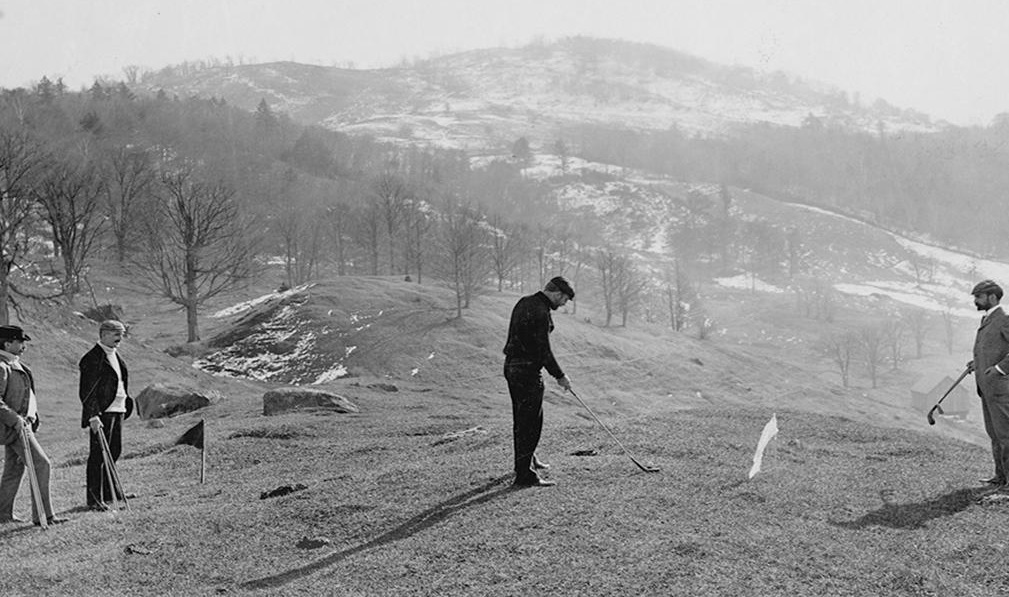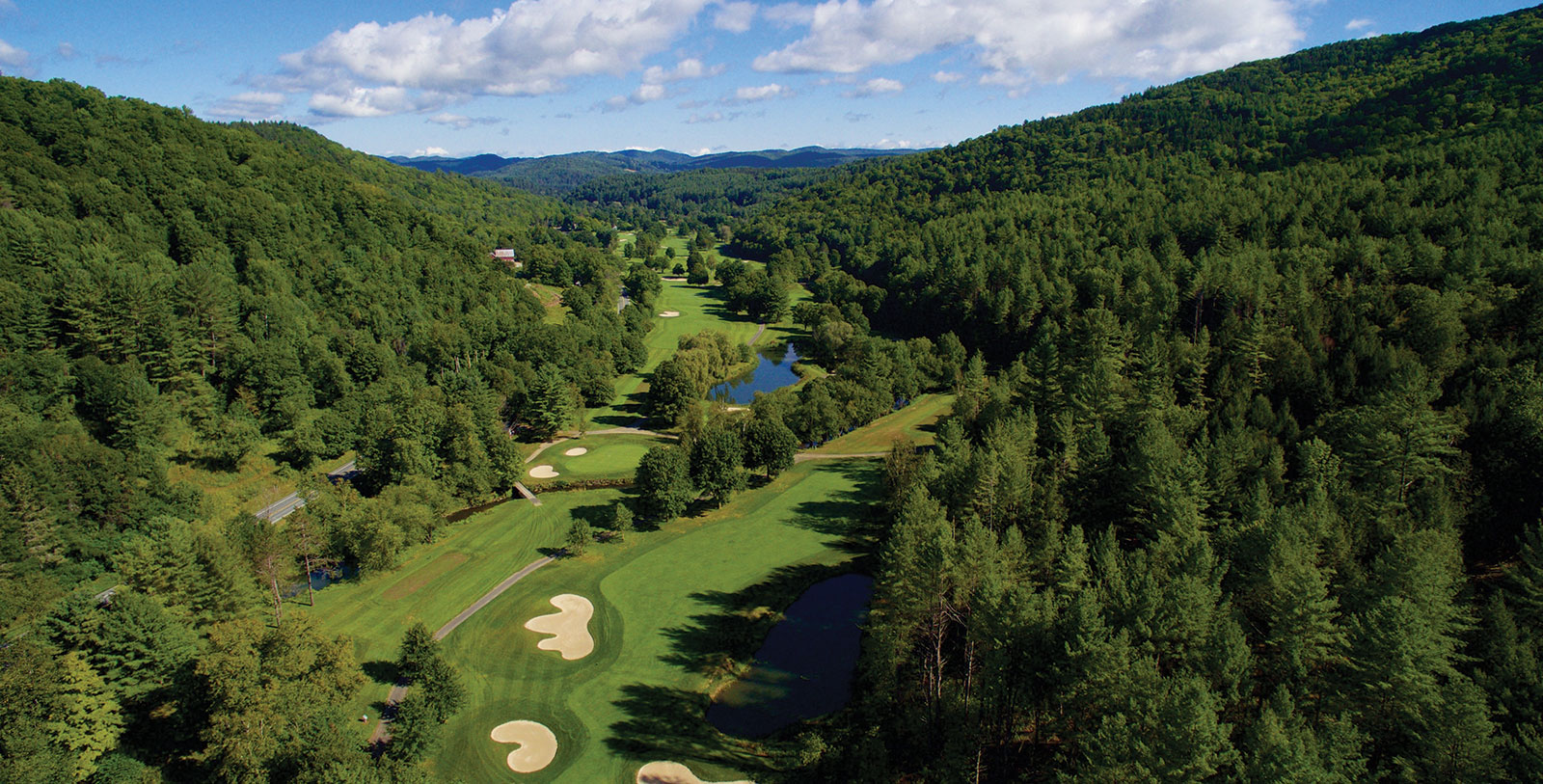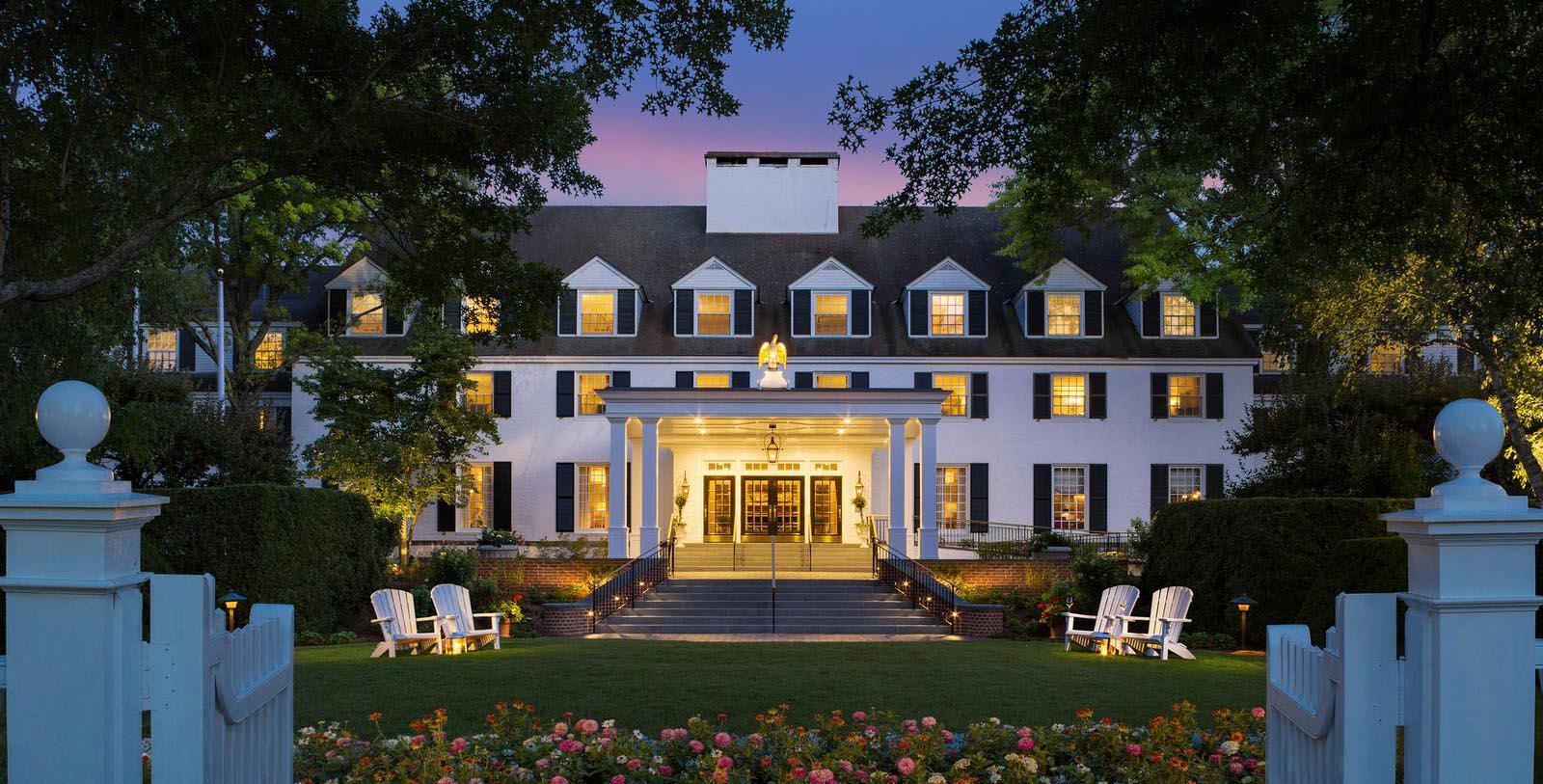Receive for Free - Discover & Explore eNewsletter monthly with advance notice of special offers, packages, and insider savings from 10% - 30% off Best Available Rates at selected hotels.
new england golf course
Discover the Woodstock Country Club, one of Vermont’s most historic public golf courses.

Woodstock Country Club
Named one of the top 100 golf resorts by Golf Magazine, the Robert Trent Jones, Sr. designed golf course at Woodstock Inn & Resort is an 18-hole masterpiece of terrain features that excite the most seasoned player.
WATCH NOWGolf at the Woodstock Inn & Resort dates to the end of the 19th century. In 1895, the inn’s staff specifically developed a nine-hole golf course after a guest—Dr. Francis B. Harrington—lamented his inability to play a round or two on-site. (He had specifically carried his golf clubs all the way north from his native Boston.) Constructed within a matter of months, the New England golf course was an immediate hit among contemporary travelers when it debuted as the “Woodstock Country Club” a year later. Despite its popularity, the course’s location was eventually abandoned in favor of a new one in 1906. Ownership subsequently selected a spot beneath Mount Peg in the Kedron Valley and began constructing the second course shortly thereafter. Designed by Willie Tucker Sr., the inn’s new course was among of the first public golf courses in Vermont. (Tucker himself was an English golf professional, who had worked as a club maker, head professional, and winning championship player before pursuing golf course architecture.) Other golf course designers installed additional features to the course over the following decades, too. For instance, Wayne Stiles expanded the course near Woodstock Inn & Resort to 18 holes in 1925. Then during the early 1960s, the great Robert Trent Jones Sr. thoroughly redesigned the course at the direction of the inn’s new owner, Laurence S. Rockefeller. Rockefeller and his wife, Woodstock-native Mary French, enjoyed Jones’ work so much that the two played regularly on the course together. (Jones also designed historic mid-century courses at Rockefeller’s Mauna Kea Beach Hotel and Colonial Williamsburg resort around the same time.) Surrounded by the lush Kedron Valley—and featuring stunning views of Mount Peg—the golf course has since remained a picturesque venue set amid an unspoiled Vermont landscape. The course boasts a par-70 layout that offers an unforgettable experience for golfers of all abilities.
-
About the Location +
Woodstock’s origins began in the waning days of British America, when the colonial Governor of New Hampshire, Benning Wentworth, first allowed British colonists to settle the land in 1761. At the time, the Province of New Hampshire claimed suzerainty over the area that now constitutes Vermont, often quarreling with New York to administer the territory. Governor Wentworth specifically allowed David Page and several dozen other families to settle the region by means of a royal land grant. Over time, more colonists from other the other New England colonies started to establish homesteads upon ground the original settlers had yet to occupy. They christened their new community after the town of Woodstock in Oxfordshire, England. On the outskirts of that Woodstock resided the regal estate of Blenheim Palace and its owner, George Spencer, the 4th Duke of Marlborough. As such, the residents of the new Woodstock felt bound to carry the memory of the lord over to the “New World.” While those families raised farms throughout the surrounding countryside, an actual village square did not emerge until James Sanderson and his family arrived around six years later. Then, in 1776, Major Joab Hoisington provided a much-needed source of income for the nascent town, constructing a gristmill and sawmill along the Qttauquechee River.
When the American Revolutionary War erupted in the mid-1770s, settlement to Woodstock slowed considerably. Yet, it picked up again once the conflict ended in 1783. The town itself soon became one of the many communities that was governed by the separate Vermont Republic, which first emerged during the Revolution. It eventually joined the United States, with the rest of the Vermont in 1791. Woodstock received a wonderful honor nearly two decades later, when the Vermont General Assembly decided to meet in the town before permanently relocating to Montpelier the following year. Factories soon began to emerge throughout Woodstock due to the strong currents of the Qttauquechee River, giving the locals a source of employment. The businesses originally produced products made of wood, such as scythes, axes, and carding machines. But as the manufacturing processes became more intricate, the plants created everything from carriages to luggage trunks. Its economic vibrancy had become so great that some 3,000 people lived in the town on the eve of the American Civil War.
Toward the end of the 19th century, the town experienced several new economic booms. One of the first began with the arrival of the Woodstock Railroad network in neighboring White River Junction in 1875. Not only did more people start to travel to Woodstock, but local merchants and industrialists started to move more goods to other markets across the nation. But as those passengers began to explore the surrounding countryside, they decided to vacation for long periods of time. Many were soon attracted to the sloping geography near Woodstock, making the town an exclusive destination for outdoor enthusiasts. Seasonal guest homes soon dotted the landscape, as well as a few hotels and inns. The greatest of those locations was the Woodstock Inn, which aspiring hoteliers developed from the Eagle Hotel in 1892. The hills and mountains near Woodstock also emerged at the sight of popular ski trails, the most notable of which was Suicide Hill. As the 20th century dawned, the town had firmly established itself as one of New England’s most luxurious holiday destination. Woodstock has maintained that identity ever since, with the great Woodstock Inn & Resort playing a central role in maintaining that status.
-
About the Architect +
Willie Tucker Sr.: Originally from Surrey, England, Willie Tucker Sr. had been around golf his entire life. Indeed, Tucker first learned how to play the sport from his father, who was a greenskeeper at Wimbeldon Common. (Tucker was also related to the respected Dunn family of golfers through his mother, Katherine Dunn.) Tucker’s father taught him everything from putting to sod rolling. Even though the younger Tucker had shown a specific affinity to golf course landscaping, he nonetheless yearned to pursue a professional playing career. As such, Tucker took up a position as the head professional at the Redhill and Reigate Golf Club after briefly working in Biarritz as a golf instructor alongside one of his uncles, Willie Dunn Jr. He eventually immigrated to New York during the late 1890s, where his brother Samuel was employed at the St. Andrews Golf Club in Yonkers. Upon his arrival, the two siblings formed a sporting goods company called “Tucker Bros., which specialized in crafting hand-made clubs and balls under the trade name “Defiance.” (Tucker himself had actually worked as a club designer at the London-based Slazenger’s.) But Tucker also found time to help his brother at St. Andrews Golf Club, going as far as to even help redesign its Mount Hope golf course. The experience was beneficial for Tucker, as it enabled him to get work designing additional courses. Among his finest designs included the work he accomplished at such places as the Ridgewood Country Club, the Philadelphia Cricket Club, and the Woodstock Country Club. (Tucker also remained an active professional golfer throughout his life, too, enrolling to compete in tournaments throughout the country. Perhaps his greatest playing moment was his top-ten finish as a contestant in the 1896 U.S. Open.)
Wayne Stiles: Despite the amazing skill he wielded to craft his iconic golf courses, Wayne Stiles was never formally trained in landscape architecture. Instead, he got his experience serving as an apprentice under the accomplished Franklin Brett during the early 20th century. Stiles worked his way up from draftsmen to be one of Brett’s junior partners in a matter of years. Nevertheless, he eventually learned of another talented landscape architect named John Van Kleek and the two formed a partnership. In 1924, Kleek and Stiles finally decided to form a landscaping firm based upon their mutual level of respect. While each man would focus on a specific area of work, the two nonetheless accepted a number of diverse jobs. Indeed, their company functioned as a subcontractor to the Olmsted family, who hired them to help with several public works assignments. The exposure soon enabled Kleek and Stiles to operate on a national level, with offices open in Boston, New York City, and St. Petersburg, Florida. Among the projects that the two soon began to pursue was the creation of golf courses all over the Eastern Seaboard. Even though the team coordinated closely on every course they designed, it was Stiles who took the lead. In fact, contemporaries often recalled how invested Stiles would become on such assignments, even walking the courses in their entirety to observe the construction firsthand. When the Great Depression finally befell the nation, Kleek and Stiles dissolved their company and went their separate ways. But the team had still developed several dozen golf courses throughout the lifetime of the partnership. Some of the most famous created under their watch included the Haverhill Country Club, the Brigantine Golf Links, and the renovations done to the Woodstock Country Club.
Robert Trent Jones Sr.: In terms of golf course design, few have had as much an impact as the celebrated Robert Trent Jones Sr. Born in England to Welsh parents at the start of the 20th century, Jones immigrated to the United States while still a young boy. Settling down in East Rochester, New York, Jones took a job caddying at the neighboring Country Club of Rochester when he had grown a bit older. The experience was a formative one for Jones, as it instilled a deep love of the game that would never fade. Indeed, he eventually entered a youth tournament that the Country Club of Rochester and shot a record-setting score of 69! He even took a position as the club professional at the Sodus Bay Heights Country Club not long thereafter, where he further honed his skills. Unfortunately, poor health forced Jones to abandon his plans of competing again. But Jones found another opportunity to pursue golf after a wealthy friend arranged to have him visit Cornell University. Enchanted with the school, Jones enrolled to study a customized series of agricultural courses that would help him develop championship-caliber golf courses in the future. In fact, Jones got to even practice some golf course architecture at Cornell, designing nine fairways to serve as its official golf course. (Now known as the “Robert Trent Jones Golf Course,” he later expanded the size of the course to 18 holes in 1954.)
Upon completing his studies in the early 1930s, Jones attempted to find work on his own. He managed to secure a commission with the Midvale Golf and Country Club on the condition that a more experienced golf course architect act as a supervisor. As such, the club’s president brought the renowned Canadian landscaper Stanley Thompson to function as Jones’ mentor. While Jones’ work at Midvale was an eventual failure—the club actually went bankrupt—the experience inspired Jones and Thompson to form a business partnership that would last for several years. The two proceeded to create numerous golf courses in both Canada and the United States, despite the onset of the Great Depression. In some cases, the men even had to rely on labor provided directly by the Works Progress Administration to finish their assignments. (Historians today point to Jones’ designs at the Green Lakes State Park as the best example of how the Works Progress Administration enabled him to complete his projects.) Nevertheless, they had managed to create some of the best golf courses in all North America, including the Capilano Golf Club outside of Vancouver and the fairways at today’s Fairmont Banff Springs. But the relationship between them began to sour over time, especially as Jones began to have his own strong opinions regarding golf course design. Thompson and Jones thus parted ways at the end of the decade.
Jones’ first real break as an independent designer occurred when the renowned golfer Bobby Jones asked for his assistance creating the Peachtree Golf Club during the 1940s. Bobby Jones was deeply impressed with Jones’ talents and invited him to redesign the 11th and 16th holes at Augusta National Golf Club. The work on both Peachtree and Augusta generated significant national acclaim for Jones, which helped him get a wealth of additional projects. (Jones had to start using his middle name “Trent” to better distinguish himself from Bobby Jones, however.) Jones proceeded to construct and/or restore several hundred courses over the next five decades, including well-regarded renovations to the Oakland Hills Country Club, the Southern Hills Country Club, and the Baltusrol Golf Club. Perhaps the greatest work that Jones accomplished was the creation of the Robert Trent Jones Golf Trail in the late 1980s. (The trail consisted of 378 public holes at eight different sites throughout Alabama.) The popularity of Jones’ work was so great that he even had his two sons—Robert Jr. and Rees—operate satellite offices on his behalf. Jones was even enlisted to craft private courses for royal dignitaries, prominent businesspeople, and even President Dwight D. Eisenhower. In all, Jones eventually worked on a total of more than 500 golf courses in 45 U.S. states and 35 other countries! Now enshrined in the World Golf Hall of Fame, Jones is remembered fondly for his wonderful designs.
































